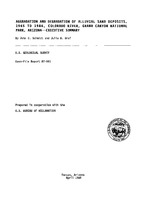High discharges that occurred in 1983-85 resulted in redistribution of sand stored in zones of recirculating current in the Colorado River in Grand Canyon National Park. Redistribution resulted in net loss in the number of reattachment deposits in narrow reaches and aggradation of some separation deposits. Separation deposits were more stable than other types of deposits. Alluvial sand deposits that are large enough and of sufficient areal extent for use as campsites were more stable than smaller lower-elevation deposits. Fluctuating flows between October 1985 and January 1986 caused erosion throughout the Grand Canyon and caused erosion of some deposits created by the high flows of 1983-85. (Author 's abstract)


